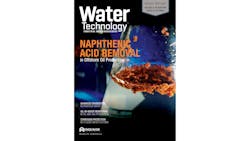Welcome to the March/April 2020 edition of Water Technology magazine. I hope that all of you are keeping healthy and safe in these unusual times. Like many of you, our staff is navigating a new (hopefully temporary) normal, learning to adapt to social distancing and working from home. Many aspects of our daily lives have changed but one remains steadfast: our mission to keep you informed about the important technologies, news, and trends in the industrial water and wastewater market.
Produced water from heavy oil reserves can exhibit high levels of naphthenic acids, which, given their amphiphilic nature, can be difficult to remove. This is proving especially challenging in Brazil where a recent regulatory change is impacting how total oil and grease (TOG) is calculated. Our cover story on page 12 examines the regulation and its implications for the analytical methodology used to determine TOG.
Continuing with the theme of produced water, our article on page 16 focuses on the instrumentation used to measure and track the flow of water through oil production, treatment, and disposal sites. Author Trever Ball discusses the importance of not only price but durability when selecting measurement devices — particularly when accuracy is critical for meeting regulatory compliance requirements.
Measuring the amount of oil in produced water is another important aspect of oil and gas production process control, water quality monitoring, and discharge reporting. On page 20, author Ming Yang discusses the advantages brought by online oil-in-water monitors, which provide continuous information that can help detect process upset conditions and be used for process optimization. Online monitors also reduce the number of laboratory samples that need to be taken, which in turn minimizes the use of solvents. Yang also outlines several recent research initiatives focused on addressing produced water issues more effectively.
Cooling water chemistry programs are, in large part, designed to treat not only the cooling water but metal surfaces as well. On page 24, authors Brad Buecker and Ray Post discuss the evolution of modern treatment methods based on products that directly attach to metal surfaces. They take a close look at the effectiveness of non-phosphorus chemistries as well as the special considerations they require.
It’s hard to think of Kentucky without also thinking of its “native spirit,” bourbon. Join us on page 36 for chat with Star Hill Farm’s environmental champion Jason Nally. He shares his passion for product quality, which depends squarely on protecting and preserving the limestone-filtered source water used to craft Maker’s Mark.
As always, we’ve compiled an assortment of products for your consideration, beginning on page 28 with our Product Spotlight on valves and actuators.
From all of us at Water Technology, here’s wishing you a healthy and happy spring. WT
Sincerely,
Angela Godwin Editorial Director
I welcome your feedback. Email your comments to me at [email protected].
About the Author
Angela Godwin
Editorial Director
Angela Godwin is the editorial director for Endeavor Business Media's Process/Water Group. With over 25 years of editorial experience, she currently oversees editorial direction for several leading brands, including WaterWorld, Water Technology, Stormwater, Processing, and P.I. Process Instrumentation magazines. She also created the popular water industry interview series The Drop. She is a graduate of the University of Massachusetts-Amherst.

